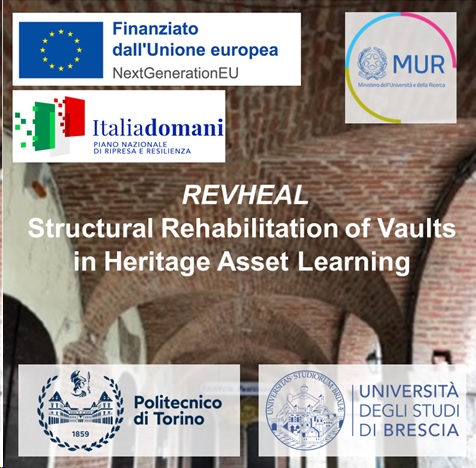REVHEAL: Structural Rehabilitation of Vaults in Heritage Asset Learning – Collapse identification and design of compatible strengthening systems supported by adaptive 3D models Coordinators: A. Monaco (Principal Investigator – PI) with E. Gandelli (vice PI)

Abstract
The structural strengthening of heritage assets is a leading sector in many European countries, including Italy, where there are high percentages of ancient masonry buildings provided with curved horizontal structures with complex geometry.
In this framework, REVHEAL is an ongoing 2-year national research project started in December 2023, which involves all young researchers belonging to two research units: Politecnico di Torino (national coordinator) and the University of Brescia (local research unit). The project was funded (Prot. P2022ZJWS3; CUP E53D23017610001) within the program “PIANO NAZIONALE DI RIPRESA E RESILIENZA (PNRR), Missione 4 “Istruzione e Ricerca” – Componente C2 Investimento 1.1, “Fondo per il Programma Nazionale di Ricerca e Progetti di Rilevante Interesse Nazionale (PRIN)”, according to “Decreto Direttoriale n. 1409 del 14 settembre 2022, Avviso pubblico per la presentazione di Progetti di ricerca di Rilevante Interesse Nazionale (PRIN) da finanziare nell’ambito del PNRR”. The project proposal was presented within the line “under 40’s investigators”.
REVHEAL will focus on the safety assessment of cross masonry vaults and the design of risk mitigation strategies in compliance with the traditional conservation criteria. The project will analytically identify the collapse mechanisms by using innovative technologies supported by 3D user-oriented digital models.
Two main objectives will be achieved. First, a methodology for the detection and classification of the expected failure mode of cross-vaulted structures will be proposed. Second, appropriate risk mitigation strategies will be proposed, through the design and modelling of suitable reinforcing systems aiming at preventing structural collapses and loss of human lives. Focus will be given to natural Textile Reinforced Matrix (TRM) composites and their mechanical properties, whose understanding represents an open issue.
REVHEAL will start from some preliminary numerical studies performed on masonry cross vaults with radial and diagonal patterns. These studies apply to some limited cases of vaults with dry joints and blocks not experiencing internal crushing. Then, an experimental campaign on small-scale vaults will be performed to validate the existing models and develop new models related to vaults that can experience failure either along not-aligned joints or within the voussoirs. The project will also provide the validation of the proposed models through real-scale tests on two pilot masonry cross vaults subjected to cyclic shear loads. The two vaults will have radial and diagonal brick patterns and will present the backfill at the extrados. The test on each vault will include two stages. The former will aim at loading the not strengthened vault till the attainment of a significant damaging condition; the latter will investigate the behaviour until failure of the pre-damaged vault after repairing with natural TRM systems. The experiments on both scale specimens will be supported by 3D digital models based on accurate point clouds and multi-scale approximated surface objects. Advanced technologies and methods for data acquisition and parametric modelling strategies for approximation will be proposed and validated. The latter will allow to investigate the relationships between model accuracy and suitability for FEM performance estimation.
REVHEAL will lead to the proposal of abacuses and guidelines for both assessing static and seismic risk scenarios and determining proper strengthening interventions. High-level approximation models for predicting the capacity and ductility improvement of strengthened vaults will be also proposed. Finally, REVHEAL will validate the proposed approach against the case study of the Palazzata of the Santuario Regina Montis Regalis in Vicoforte in Italy.
Participants
Alessia Monaco (PI), assistant professor in structural engineering, Politecnico di Torino Contact: alessia.monaco@polito.it
Emanuele Gandelli (vice PI), assistant professor in structural engineering, University of Brescia Contact: emanuele.gandelli@unibs.it
Marco Alforno, assistant professor in structural engineering, Politecnico di Torino Contact: marco.alforno@polito.it
Marco Avena, PhD student in geomatics, Politecnico di Torino Contact : s302867@studenti.polito.it
Luca Facconi, assistant professor in structural engineering, University of Brescia Contact: luca.facconi@unibs.it
Emiliano Matta, associate professor in structural engineering, Politecnico di Torino Contact: emiliano.matta@polito.it
Giulia Sammartano, assistant professor in geomatics, Politecnico di Torino Contact: giulia.sammartano@polito.it
Fiammetta Venuti, assistant professor in structural engineering, Politecnico di Torino Contact: fiammetta.venuti@polito.it
Short Bibliography
M. Alforno, F. Venuti, A. Monaco, C. Calderini, ‘Seismic behaviour of cross vaults with different masonry apparatus’, Bulletin of Earthquake Engineering, vol. 20, 2022, pp. 3921–3939
G. Patrucco, S. Perri, G. Sammartano, E. Fillia, I. Matteini, E. Lenticchia, R. Ceravolo, A. Spanò, ‘3D models and non-destructive investigations: towards a meeting in digital twins’, Int Arch Photogramm Remote Sens Spatial Inf Sci, XLIII-B2, 2022, pp. 845-852.
M. Alforno, F. Venuti, A. Monaco, C. Calderini, ‘Numerical investigation of the influence of constructive aspects on the structural behaviour of masonry cross vaults’, International Journal of Architectural Heritage, vol. 17, no. 6, 2021, pp. 868-891
M. Alforno, A. Monaco, F. Venuti, C. Calderini, ‘Validation of simplified micro-models for the static analysis of masonry arches and vaults’, International Journal of Architectural Heritage, vol. 15, no. 8, 2021, pp. 1196-1212
S.S. Lucchini, L. Facconi, F. Minelli, G. Plizzari, ‘Cyclic Test on a Full-Scale Unreinforced Masonry Building Repaired with Steel Fiber-Reinforced Mortar Coating’, J Struct Eng, vol. 147, no. 6, 2021, article number 04021059.
M. Alforno, F. Venuti, A. Monaco, ‘The structural effects of micro-geometry on masonry vaults’, Nexus Network Journal, vol. 22, 2020, pp. 1237–1258
L. Facconi, F. Minelli, S.S. Lucchini, G. Plizzari, ‘Experimental Study of Solid and Hollow Clay Brick Masonry Walls Retrofitted by Steel Fiber-Reinforced Mortar Coating’, J Earth Eng, vol. 24, no. 3, 2020, pp. 381-402.
A. De Stefano, E. Matta, P. Clemente, ‘Structural health monitoring of historical heritage in Italy: some relevant experiences’, Journal of Civil Structural Health Monitoring, vol. 6, no. 1, 2016, pp. 83-106.
